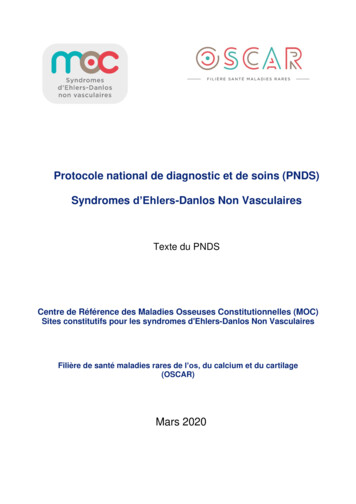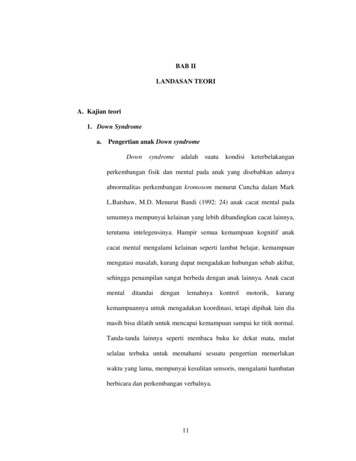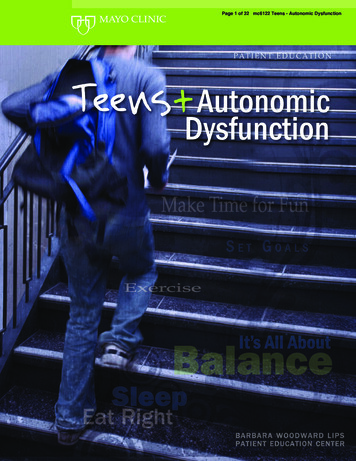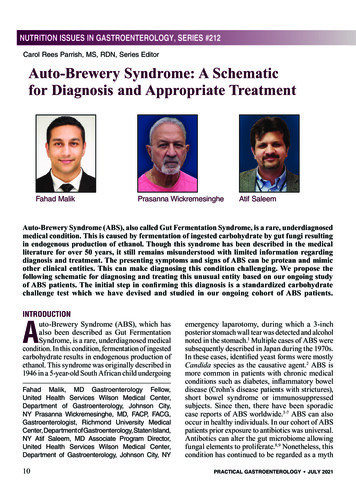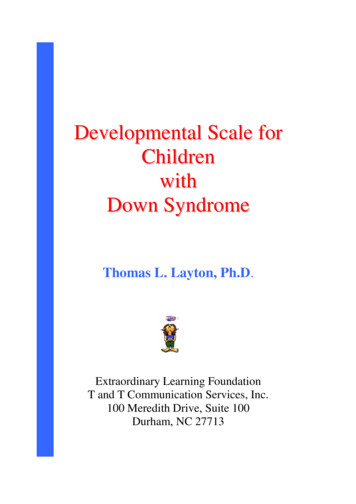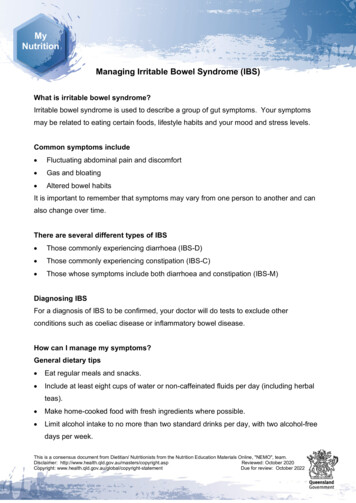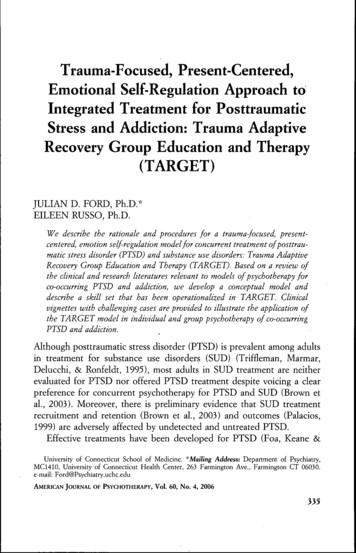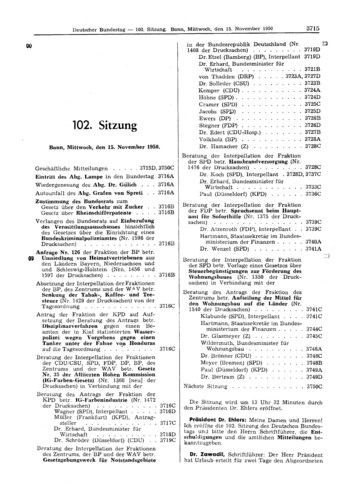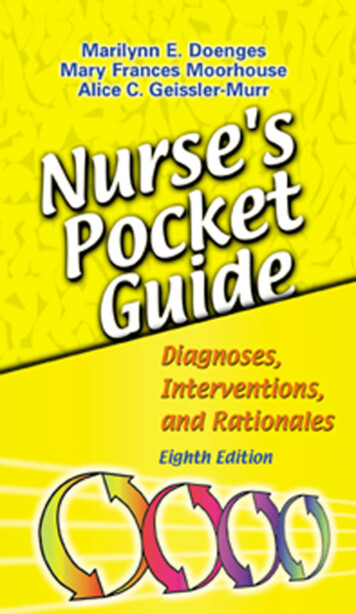
Transcription
SN Comprehensive Clinical Medicine(2022) GINAL PAPEREstablishing an Ehlers‑Danlos Syndrome Clinic: Lessons LearnedDacre R. T. Knight1 · Sunnie M. Confiado2 · Katelyn A. Bruno3 · DeLisa Fairweather3 · Andrea M. Seymour‑Sonnier1 ·Angita Jain3 · Jessica M. Gehin1 · Emily R. Whelan3 · Joshua H. Culberson3 · Bala Munipalli1 · Nancy L. Dawson1 ·Todd D. Rozen4 · Joseph J. Wick5 · Archana Kotha3Accepted: 22 June 2022 The Author(s) 2022AbstractIn a large academic medical center, patient requests from the community and internal referrals for evaluation of suspectedhypermobility conditions were being denied consultation because services specific to this condition were not available. Weidentified this gap and developed a comprehensive evaluation for this unique patient population. The objective of this paperis to demonstrate a solution for improving outcomes in a neglected patient population by establishing an innovative outpatientclinic specifically tailored for patients with EDS.We describe the lessons learned on establishing a specialty clinic for treating patients with hypermobility syndromes including hypermobile Ehlers-Danlos syndrome (hEDS) and hypermobile syndrome disorder (HSD). Findings were collected froma patient focus group that was instrumental in understanding common care gaps. We document the firsthand perspective ofthree patients presenting with hypermobility accompanied by joint pain and denote the complicated state of healthcare inrecognizing and treating this condition. A summary of patient demographics and characteristics was collected from patientsseen in the clinic from November 14, 2019 to April 13, 2021.The firsthand accounts illustrate the challenges faced in treating this condition and the need for, and success of, this clinicusing a coordinated care model. Demographics reveal a primarily white female population under the age of 50 with manycomorbidities. Genetic testing was largely negative, with more patients diagnosed with HSD than hEDS.Our shared experience of launching a successful EDS clinic may assist other clinicians in establishing similar care models.Keywords Ehlers-Danlos syndrome · Hypermobility spectrum disorder · Hypermobile Ehlers-Danlos syndrome · Patientfocus group · Translational researchDacre R. T. Knight, Sunnie M. Confiado, Katelyn A. Bruno, DeLisaFairweather, Andrea M. Seymour-Sonnier, Angita Jain, and JessicaM. Gehin are equal senior authors.This article is part of the Topical Collection on MedicineAbbreviationsEDS Ehlers-Danlos syndromehEDS Hypermobile Ehlers-Danlos syndromeHSD Hypermobility spectrum disorderVUS Variant of unknown significance* Dacre R. T. KnightKnight.Dacre@mayo.eduIntroduction1Department of General Internal Medicine, Mayo Clinic,4500 San Pablo Rd, Jacksonville, FL 32224, USA2Department of Clinical Genomics, Mayo Clinic, Jacksonville,FL, USA3Department of Cardiovascular Medicine, Mayo Clinic,Jacksonville, FL, USA4Department of Neurology, Mayo Clinic, Jacksonville, FL,USA5Department of Research Services, Mayo Clinic, Rochester,MN, USAEhlers-Danlos syndrome (EDS) is a heterogeneous groupof hereditary connective tissue disorders, characterized byjoint hypermobility, skin hyperextensibility, easy bruisingand tissue fragility [1–3]. These features are present in allEDS subtypes in varying degrees and help to differentiate EDS from other hypermobility disorders. EDS affectsapproximately one in 5000 people worldwide [3–6]. Thegenetic (i.e., molecular) cause of EDS is known for all butone named subtype. Variants in 20 different genes encodeVol.:(0123456789)
138Page 2 of 10fibrillary collagen types I, III and V, encode modifyingand processing enzymes for these proteins, and/or encodeenzymes that modify glycosaminoglycan chains of proteoglycans that lead to connective tissue dysfunction [2, 7].Because EDS can involve essentially every organ system, itis a challenging disorder to diagnose and manage. EDS features overlap with other connective tissue disorders including Marfan syndrome and osteogenesis imperfecta [3, 8–11].No identifiable gene has been associated with hypermobile EDS (hEDS) or hypermobility syndrome disorder(HSD). Patients with hEDS and HSD are diagnosed basedon clinical criteria developed by the International Consortium on EDS that was updated in 2017 [3, 12, 13]. EDS wasonce considered relatively rare [3, 14]. Although increasedawareness in the medical community and increased patientawareness through online access have resulted in greateridentification of this disorder in recent years, there remainsa large area of unmet needs for patients suffering from EDS[15]. Because of variations in symptom presentation, symptom severity, and lack of a genetic marker, diagnosis hasbeen estimated to be delayed up to 14 years [16, 17]. For25% of patients, it took over 28 years to obtain an hEDSdiagnosis [16, 17]. For those reasons, the prevalence ofhEDS/HSD is suspected to be higher than reported [18].Despite recent advances in genetic diagnosis, testing andresearch, there is a significant gap in care for patients withhEDS/HSD. To date, there are no specific medical or genetictherapies available to care for patients with any type of EDS.There are other well-known specialty genetics clinics worldwide [19], but this is the first known report on establishing adedicated EDS clinic at a large academic medical center. TheEDS Clinic at Mayo Clinic in Florida was started in November 2019 to provide diagnosis and specialized care in thehope of advancing the science of these disorders. Barriersto care for hEDS/HSD patients include limited primary careeducation and overburdened genetic practices. To addressthese barriers and to provide a blueprint for clinic development, we established a de novo outpatient EDS clinic withinan academic adult general internal medicine practice andmonitored its progress over 1 year. Little is published documenting the benefits of caring for these patients, and evenless on establishing a focused medical practice for patientswith hEDS/HSD. Herein, we provide our experience withestablishing an EDS clinic.MethodsClinic DemographicsRetrospective review of the demographic and clinical datafrom the medical records reported in this manuscript wasapproved by the Mayo Clinic Institutional Review Board(IRB# 19–011,260) and informed consent was waived bySN Comprehensive Clinical Medicine(2022) 4:138the Institutional Review Board for all patients. The researchconformed to the principles outlined in the Declaration ofHelsinki.Statistical AnalysisContinuous variables were summarized as mean (average)or range (minimum and maximum) where appropriate andcategorical variables were reported as frequency (percentage). The analyses were conducted using Prism.ResultsThe ClinicTo lay the foundation for starting the clinic, specificpersonnel were required, including an administrator, aphysician, a dedicated full-time nurse, a scheduler, anda medical geneticist available for referrals. The EDSClinic calendar is consistently full, and the clinic operates four half days per week typically seeing 4 patients aday. There has been no formal advertisement of the EDSClinic outside of our institution, meaning that patientswho self-refer are made aware of the clinic primarilythrough internet searches (The EDS Society Directory),discussion forums, and word of mouth. The appointmentsare 60 min long. Once evaluated in the EDS Clinic, thephysician recommends subspecialty consultations basedon medical needs. Consult appointments were arranged asclose to original appointment as possible, especially forpatients traveling from great distances, but most subspecialty appointments were obtained within 2–3 months ofentering the Clinic. The major consults that were recommended in this cohort of patients in the first year of theClinic based on the intake questionnaire are summarizedin Table 1.Unique to this EDS Clinic, patient care was integratedwith research from its inception to gain a better understanding of the underlying mechanisms that contribute tothis understudied condition. The link between physiciansand researchers/basic research was critical for promotingadvances in translating knowledge to the clinical practice.Research staff working on the study were largely volunteeruntil enough data could be collected to obtain external funding to support research and staff effort. Research personnelfinancially supported by the Clinic include an Associate Professor and supplies for collecting and processing blood samples. Volunteer research staff include an Assistant Professor,Research Fellow, and three technicians/students. All patientswere invited to participate in research; blood samples wereobtained if consent was given.Research on data and samples is conducted on an ongoing basis. Current areas of research include, but are notlimited to, sex differences, fibromyalgia, mast cell disorders,
SN Comprehensive Clinical MedicineTable 1 Recommended consultsfor patients seen at the EDSClinic based on the intakequestionnairePage 3 of 10(2022) 4:138Referral consult%‡Physical TherapyOccupational TherapyPOTS ClinicGastroenterologyPain ClinicCardiologyPsychologyNeurologySleep CenterFibromyalgia ClinicWomen’s HealthPelvic Floor .285.282.584.876.371.467.047.633.833.0‡%: percentagetelemedicine, genetic pathology, and population studies.Research findings are published and shared on our Clinicwebsite (https:// conne ct. mayoc linic. org/ blog/ ehlers- danlos- syndr ome/) after publication, in which patients are invitedto “follow” for research updates as they become available.The workflow of the EDS Clinic was specifically designedto allow comprehensive assessments, testing and follow-up(Fig. 1). Patients were asked to complete a standard of care138intake questionnaire online before their first appointment.At the initial visit, the patient was evaluated by gatheringpersonal, family, and medical history, creating a geneticpedigree, performing a full physical exam, cardiac imaging,and individualized laboratory assessments. Cardiac imaging included echocardiography, evaluating for valve prolapseand aortic root dilatation based on strict echocardiographiccriteria [20]. Upon this evaluation, and if indicated by concern for an EDS subtype other than hEDS, genetic phenotype-driven panel testing was conducted by the Mayo ClinicMedical Laboratory after obtaining authorization for genetictesting from the patient. The Ehlers-Danlos syndrome12-gene panel (ADAMTS2, ATP7A, CHST14, COL1A1,COL1A2, COL3A1, COL5A1, COL5A2, FKBP14, FLNA,PLOD1, and SLC39A13) was used. All genes identified asknown causes of EDS are included in this panel. Separatebroader connective tissue panels were ordered if there wasconcern for a separate non-EDS inherited connective tissue disorder. A prior authorization process for genetic testing coverage was performed independently between MayoClinic and the patient’s insurance. Of the 483 patients whohad genetic testing results from November 2019 throughApril 2021, 73 patients provided previous results and 410patients completed genetic testing through the EDS Clinic.Of the 410 patients, 255 patients utilized the commercial lab.Pathogenicity of genetic variants were determined bythe designated lab after review of known variants, genetic Standard: Physical Therapy Occupa onalTherapyA er VisitTests Self-referral Primary carereferral Specialty referral Internal (MayoClinic) referralIntake SourceBefore Visit Nurse triage Medical IntakeQues onnaire Consent forreseaarch Family history andPedigree Comprehensivemedicalconsulta on Gene c tes ng (ifindicated) Blood work Research blooddraw (if consented)Clinic Visit Standard: Echocardiogram(ECHO) Op onal: Autonomic reflexscreening Electrocardiogram(EKG) Holter monitor Chest X-ray Spine imaging Pharmacogenomictes ng Op onal: Pelvic floor therapy Integra veMedicine Mind Bodyconsulta on Fibromyalgiaconsulta on Gastroenterology Clinical Genomics NeurologyHeadache Clinic Spine Clinic POTS Clinic Allergy/Immunology Cardiology PMR Orthopedics Dermatology Women’s HealthClinic Endocrinology HematologyReferralsFig. 1 EDS Clinic workflow. This figure describes the intake of patients to the EDS Clinic and each step through their careFollow up Video visit todiscuss results andreferrals Provide a plan forongoing care atMayo Clinic oroutside providers
138Page 4 of 10conservation, and prediction of changes to protein structure.In patients where novel variants were identified and classified as variants of uncertain significance (VUS), the EDSClinic coordinated a referral to clinical genomics.A second visit was conducted by video to review labresults, imaging and, if ordered — genetic testing results.They also received education about their condition. Referralsfor additional specialty appointments and diagnostic testingwere placed based on the individual medical needs.Patients returned to Mayo Clinic to complete specialtyappointments and diagnostic testing. At that time, patientshad the opportunity to develop treatment plans with individual specialties. This multidisciplinary team approachensured patients were evaluated and treated using a widearray of modalities and treatment plans. Shared decisionmaking between provider and patient directed the courseof treatment.The final visit was held by telehealth. This appointmentserved to summarize and integrate all previous referrals anddiagnostic testing and outline treatment recommendationsfor continued care with the primary care provider, whichwas often not at our institution. There are cases where primary care physicians lack sufficient expertise or interest incaring for patients with hEDS/HSD. However, every patientmaintains direct access to the EDS Clinic care team for significant medical issues that arise following their evaluations.Furthermore, every patient is given an individual care planand documentation to share with their primary care team.Patient and Advisory Focus GroupsWhen the EDS Clinic was first being designed, Mayo Clinicin Florida invited a cohort of hEDS and HSD patients (n 6)to a targeted focus group session. The objective was toreceive and utilize feedback from a representative group thatincluded patients from diverse demographic backgrounds.Patients identified several major themes, including obtainingthe right care at the right time, access to multidisciplinary,holistic, and coordinated care and additional educationalresources. The Mayo Clinic EDS Clinic continues to meetwith EDS/HSD patient focus groups to gain perspective onongoing patient concerns.The Clinic members also meet monthly with an EDSAdvisory Forum consisting of clinical and research stakeholders with the goal of providing education, encouraging,and disseminating research and improving patient care.Patient PerspectivesMany of the patients seen over the year are not only aware ofcurrent EDS research but are also cognizant of deficienciesin the patient care community for people with hEDS/HSD.SN Comprehensive Clinical Medicine(2022) 4:138We share the viewpoint of three of our hEDS/HSD advisorygroup patients with their consent.“Through the years I have seen a need for centers ofexcellence for EDS. The hope is that that there will be multiple people working together while sharing knowledge andresearch.As an EDS patient and advocate, I view the EDS Clinic as aresource for local doctors but also for me and for those I supportas a place to go to get answers and help. Ultimately, I would likemy grandchildren and nieces to avoid suffering my fate.” [KA].“From an early age I had what my orthopedist told mewere growing pains. Because I was taller than most of myclassmates, I did my best to accept his answer, although Ialways wondered if it weren't something more (especiallyafter I stopped growing!).Now I'm devouring any information I can get on hEDSto manage it and get as optimal health as possible.” [EE].“After 20 years of receiving wrong diagnoses (conversion disorder, psychological pain, etc.) and after having hadcountless visits and exams in Italy and the US, I decided totake the matter in my hands. Around that time, I tore my ACLand fractured the tibial plateau just by standing up and thedoctors could not explain it. I started studying genetic diseases connected to some of my symptoms and when I foundout about the existence of EDS, I knew it was what I wassuffering from.My experience at the EDS clinic was life changing. I wasso blown-away at the preparation, brilliancy and intelligence, communication skills and genuine care for the patientof the clinic providers that in just a few weeks I made majorchanges to my life—activities, priorities, scheduling, etc.– as they had suggested (something that I would have neverthought possible!). What strikes me the most is the doctors’ability to see things in an integrated way, and care for mywellness more than for my health.” [MS].Clinic DemographicsBetween November 14, 2019 and April 13, 2021, 563 adult( 18 years of age) patients entered the Mayo Clinic FloridaEDS Clinic. Any adult patient with suspected joint hypermobility or a possible connective tissue disorder was scheduled. Most patients were female (91.9%) with only 44 males(7.8%) and two non-binary patients.Of the 563 patients who were seen at the EDS Clinicduring this time, 503 patients completed the intake questionnaire and demographic comparisons are made with thissubpopulation. In this subgroup, of the 92.0% of patientsthat were female (age range: 18–75), 86.1% were under50 years of age. Of the 7.6% of patients that were male (agerange: 18–60), 94.7% were under 50 years of age. Mostpatients were White (93.0%), with few Hispanic or Latino
SN Comprehensive Clinical MedicinePage 5 of 10(2022) 4:138patients (6.7%), and patients had varying levels of education(Table 2). In the intake questionnaire, patients were askedif they were previously assessed for some form of hypermobility. Of the 503 patients who answered this question,55.0% stated they had been assessed previously, with 52.5%diagnosed with hEDS and 9.9% with HSD. Only 7.6% of thepatients had multiple family members seen at the Clinic, butmany patients reported that multiple members of their familywere also hypermobile (60.0%) (Table 3).Patients who had not received genetic testing previouslywere offered genetic testing as part of the EDS Clinic. Theaverage cost to the patient who underwent genetic testingwas 343, with a range from 0 to 600 and results wereobtained in 45 days on average, ranging from 15 to 60 days.Of the patients seen through April 13, 2021 (n 563), 76patients did not have genetic testing completed, four patientshad pending genetic testing results and 483 had receivedgenetic testing results. Of the 483 patients with results, 338had no findings of pathogenic connective tissue variants(70%), 136 had a VUS or an inconclusive result (28.1%)and nine patients had pathogenic or likely pathogenic variants (1.9%) (Table 4).Most patients seen at the EDS Clinic were diagnosedeither with hEDS or HSD. Physician diagnosis was extractedfor 489 patients revealing that 40.5% were diagnosed withhEDS, 47.6% were diagnosed with HSD, and 11.9% werenot diagnosed with a hypermobile connective tissue condition (Table 5).The most common self-reported complaints (comorbidities) are included in Table 6.Lessons LearnedContinuous improvement based on patient feedback is afoundational element of the Clinic. Patient expectations wereclosely monitored during the first year and continue to beevaluated to enable improvement. As this is a novel report,we are eager to share this experience as soon as possible.Below are the major topics the team focused on in the firstyear of the new clinic.Genetic TestingFrom our experience, and as described by Sulli et al. onunmet needs — lack of practice guidelines, we recognize awide variation in protocol among providers treating patientsfor EDS [15]. Testing is based on clinical findings, as thisis the role of the physician. Clinical findings focus on connective tissue exams and family history. Among the majority we observed, patients more readily entered the path tofunctional restoration upon gaining their own acceptance ofa diagnostic test result. Clinician reassurance alone in ourexperience was not adequate for a small number of patients138interested in ruling out more severe subtypes of EDS. Aspatient buy-in is pivotal to good outcomes, we recognizethe importance of further research on outcomes to developthe best evidence-based process for genetic testing. Strictlyspeaking, a diagnosis of hEDS/HSD does not warrantgenetic testing as there is currently no positive result norchange in management to be found for these diagnoses. Others have made good points against haphazard genetic testing[21]. However, overlap with similar conditions for whichgenetic testing is indicated does confuse the matter, andlargely relies on clinical expertise to evaluate the medicalhistory and physical examination to determine the utility ofa genetic test. The more proficient and experienced clinicianwill be able to target a smaller range of connective tissuediseases to a single panel. A rich debate is to be had whetherthe safer, if not costlier approach is to order broad panels, oreven exome studies. The cost of exome sequencing is rapidlyfalling. For now, it must be left to the clinician’s designationand pretest probability assessment for whichever disordermay be considered beyond the non-testable hEDS/HSD.Pre‑Visit PlanningThe patient journey was designed in a series of three distinctstages that included (1) obtaining the history, pedigree andcompleting testing, (2) reviewing testing results and outlining the plan of care for future comprehensive evaluation, and(3) completion of the multispecialty comprehensive evaluation of medical concerns. To prevent delays in overall care,the clinical team began pre-scheduling specialty consultsbased on the results obtained in the intake questionnaires.When the patient was examined, appointments were cancelled or added based on individual medical needs.Electronic CommunicationThe level of clerical burden associated with electronic communication between the care team and the patients was notanticipated to the extent observed with this population.The clinical team created an orientation letter that briefedpatients on the clinic, outlined what to expect and answeredfrequently asked questions. The information helped redirectthe focus on clinical questions versus operational or generalquestions. Electronic consent for research was implementedto reduce workload to the clinical team at the initial day ofvisit.Expertise of Clinical TeamOur full-time equivalent structure of the core team is as follows: physician (general internal medicine), nurse, physical therapy, and occupational therapy for each patient. Forthis cohort, care was provided with at least one specialist in
138Page 6 of 10Table 2 Patient demographicsduring the first year of the EDSClinicSN Comprehensive Clinical MedicineSex (n 503)Race (n 503)Ethnicity (n 503)Highest level of education(n 503)Residence (n 503)†‡n: number%: percentage(2022) 4:138n†%‡FemalesFemales 50 at diagnosisFemales 50 at diagnosisMalesMales 50 at diagnosisMales 50 at diagnosisNon-Binary (NB)NB 50 at diagnosisNB 50 at diagnosisChoose not to disclose/UnknownMean age at diagnosisFemales (Range: 18–75)Males (Range: 18–60)Patients were able to choose multiple answersAmerican Indian/Alaska NativeAsianAfrican AmericanNative Hawaii/ Pacific IslanderWhiteMultiple 91.11.5Hispanic/LatinoNot Hispanic LatinoUnknown33451196.789.63.7Some high school, no diplomaHigh school graduate, diploma or GEDSome collegeTrade/technical/vocational schoolAssociate degreeBachelor’s degreeMaster’s degreeProfessional/Doctorate (JD, MD, PhD, etc.) degreeChoose not to .329.214.03.70.45.6FloridaGeorgiaAlabamaNorth CarolinaSouth CarolinaOther 4
SN Comprehensive Clinical Medicine(2022) 4:138Page 7 of 10138n†%‡Table 3 History of hypermobilityAssessed previously for hypermobility (n 503)Previously diagnosed with the following conditions (n 303)Previous genetic testing (n 277)Family member with similar diagnosis (n 503)Severity of family’s symptoms in relation to your symptoms (n 302)Have family members been seen in the EDS Clinic? (n 503)†‡§YesNoUnknownUnansweredPatients were able to choose multiple answersHypermobile SyndromeHypermobile Spectrum DisorderHypermobile Ehlers-Danlos SyndromeGeneral Ehlers-Danlos SyndromeOther types of EDS§No previous diagnosisUnknown/ Not 633.962.14.0YesNoUnknownNot answeredPatients were able to choose multiple answersLess severeSameMore 2047.651.840.6n: number%: percentageEDS: Ehlers-Danlos syndromeTable 4 Genetic testing resultsfor EDS Clinic patientsNo pathogenic connective tissue variantsVariant of unknown significance or inconclusive resultPathogenic variants/ variant of unknown likely pathogenic†‡n: number%: percentage(Total 483)n†%‡338136970.028.11.9
138Page 8 of 10SN Comprehensive Clinical MedicineTable 5 Documented diagnosis after physician’s evaluation at theEDS Clinic(Total 563)n†hEDS§221HSD¶269Does not meet criteria for hEDS/ 73HSD†‡§¶%‡39.247.813.0n: numberhEDS: hypermobile Ehlers-Danlos syndromeHSD: hypermobile spectrum disorderCommon comorbidities/diagnosis(Total 503)n†%‡Chronic pain(pain lasting 3–6 months)Brain FogHeadacheAnxietyChronic aTinnitusCervicalgiaInsomniaVertigoSleep disturbancesAutonomic .055.351.951.249.545.042.341.540.635.731.0‡in Table 6 and include functional gastrointestinal disorders,headache disorders, dysautonomia, fibromyalgia and chronicpain, among others. The more versed any specialist is inEDS treatment, the better the care as the optimal treatmentapproach is dynamic such that treatment modalities in onediscipline may interfere with another discipline. Therefore,it is beneficial to have an experienced general medical physician to balance the care where such conflict might arise.Virtual Visits%: percentageTable 6 Common comorbidities self-reported by patients seen at theEDS Clinic†(2022) 4:138n: number%: percentageinternal medicine, nursing, physical therapy, occupationaltherapy, psychology, medical genomics, cardiology, neurology, and/or gastroenterology. Allied health professionals were also an invaluable part of the care process. Theseinclude a mind–body therapist, health and wellness coach,and dietician. There is not yet an accredited specialty training curriculum for EDS outside of a clinical genetics residency, so expertise is gained from research, self-education,and clinical experience. This applies to physicians, as well asnursing, and therapy staff involved in the clinic. Determination for the specialty referral was made based on a clinicalevaluation of comorbid conditions. These are highlightedThree months after the new clinic opened, the COVID-19 pandemic impacted healthcare facilities across the country. Alongwith most outpatient clinics, the EDS Clinic staff were redirected to COVID-19–related activities. As a result of the pandemic, patients were unable to travel if outside of the immediate area. The team implemented virtual visits for the initialevaluation and follow-up appointments to navigate the shift inhealthcare. Patient satisfaction varied with virtual visits.Care ModelThe EDS Clinic is a tertiary care model rather than a primary care model. The clinical pathways designed wereintentional to provide accessibility to as many patients aspossible and contribute to the overall body of research. Foreach patient, the clinical team completed a full diagnosticwork-up, assisted the patient in creating a treatment plan,and transitioned the patient to their local primary care provider for ongoing care.DiscussionThe Mayo Clinic Model of Care is defined by high-quality,compassionate multidisciplinary medical care deliveredin an integrated academic institution [22, 23], and formedthe foundation for our new multidisciplinary EDS Clinic.This clinic has been successful because of its ability to provide multidisciplinary care consisting of an initial visit todiagnose the condition and establish care and a subsequentvisit(s) to identify further modalities for individualizedtreatment. The direct feedback from the multi-disciplinaryteam has been positive, by providing a home to patientswith a care team that is eager to help them. Interaction withresearchers who had characterized the hEDS/HSD population previously seen at Mayo Clinic prior to the start of theEDS Clinic was pivotal to the success of the clinic as well.Their research was used as evidence for the need and feasibility of the Clinic as well as ascertaining key elementsto include in the intake questionnaire. Equally importantwas interacting with patients with hEDS/HSD to betterunderstand the needs of the community and the breadth ofthe comorbidities associated with the condition to better
SN Comprehensive Clinical Medicineanticipate referrals. The Clinic works closely with basic,clinical, and translational researchers studying hEDS/HSD.Ultimately, the Clinic focuses on individualizing care at thepatient level. This is particularly important with such a broadand multi-system condition. To this end, treatment for patientsincludes the primary goal of improving quality of life by focusing on improving physical function with st
Clinic Demographics Retrospective review of the demographic and clinical data from the medical records reported in this manuscript was approved by the Mayo Clinic Institutional Review Board (IRB# 19-011,260) and informed consent was waived by the Institutional Review Board for all patients. The research
